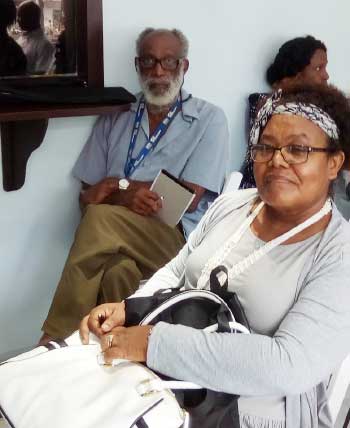
MONDAY, June 19 marked the 69th anniversary of a devastating period in the history of Castries. It was the day when the city died, literally, when a great fire leveled the city and forced its reconstruction.
The rebuilt city is today the stuff of historians and poets and that chapter in the city’s life is what historian Gregor Williams and archivist Margot Thomas are urging St. Lucians not to forget.
Williams and Thomas were speakers at a ceremony hosted by the Castries Constituency Council last week Tuesday at its offices in observance of the destruction which displaced over 2,000 families.
Williams, who was in his first year at St. Mary’s College at the time of the fire, said he actually witnessed the fire which started from a tailor’s shop.
“I was there when the fire started,” he said, “but I was not the one who started it,” he quickly added with a laugh.
The historian recounted how he was on his way home from visiting his father at his workplace when: “I stopped, and there was this smoke coming out of this house belonging to someone by the name of Adonis. There was a tailor with a shop on the ground floor named Alice. I saw this smoke coming out of the building.
He continued: “I dashed towards a couple friends and told them a building was on fire. I then rushed to the Council, which was next to the fire station, and told my dad there was a fire. I went back to see the fire.”
He remembered his father and other men trying to fight the fire but to no avail: “There was no functioning fire engine. The thing was a derelict, it was under a building, children used to play on it,” Williams said.
“On the other side of the road was a rum shop and that started to produce smoke. Then we heard boom! Rum bottles started to break, alcohol being flammable. By the time the night ended, over four-fifths of the town was burned,” Williams said.
Williams said people panicked when the flames, helped by a healthy breeze, hungrily ate up buildings.
The fire, Williams said, started on Jeremie Street and moved all the way to Manoel Street, up to the river by the bridge, and towards Brazil Street and Micoud Street, leveling everything in its path.
“All that remained were a few shacks on Micoud Street…The asphalt on the streets had all peeled off. Metal embedded in buildings was all twisted up. I remember the smell of burning salt fish,” Williams said.
According to him, the cost of the fire at the time was estimated at about 2 million pounds sterling. The British helped in constructing the buildings now known as the CDCs, the post office, the courthouse and the now-demolished fire station.
“They (the British) put in a sewerage system for Castries. A British construction company built it. Most government buildings were burned except the power station, the telephone exchange, the police headquarters, the agriculture building, public works and the medical department,” Williams said.
He said the Cathedral, St. Mary’s College — located at the time where the parish center is presently positioned — and St. Joseph’s Convent were saved by people dousing their walls with water.
Thomas, a National Archivist, said that while she was not yet born when the devastation took place, her knowledge of the fire is based on records of the event.
She spoke about five fires that caused tremendous damage to Castries, the first one occurring in 1796, and dubbed Castries “fire prone”.
The 1796 fire was blamed on the British and the French as the two nations were at the time battling over ownership of the island. According to Thomas, their frequent fights destroyed Castries completely.
“In March 1805, Castries was destroyed by fire. On April 6, 1813, Castries was destroyed to the extent where there were only two houses standing on Chaussee Road. In 1927, on May 14 and 15, the fire in Castries was so intense that the administrative buildings like the Treasury, courthouse and Attorney General departments were all destroyed,” Thomas said.
She noted that the fires destroyed a significant portion of the country’s records but certain lessons were learned, especially from the 1948 fire.
She called for the fire department to be staffed with fully trained personnel and provided with the best equipment to fight fires and for citizens to not delay on reporting a building on fire as was the case in the 1948 fire.
“A fire never tells us when it’s going to break out. Let us always be ready,” Thomas said.
Meanwhile, Castries Mayor Peterson Francis said such disasters should have been a stepping stone to mould and mend a society, not just to reconstruct a city.















The reason why people have a mouth and two ears is because they listen twice as much as they say